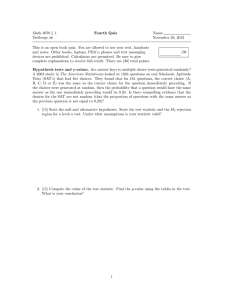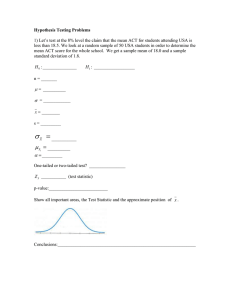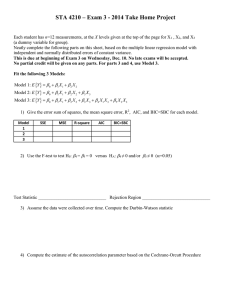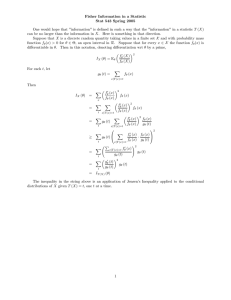STA 6167 – Spring 2012 – Exam 1 – PRINT ... Note: Conduct all tests at = 0.05 significance level.
advertisement
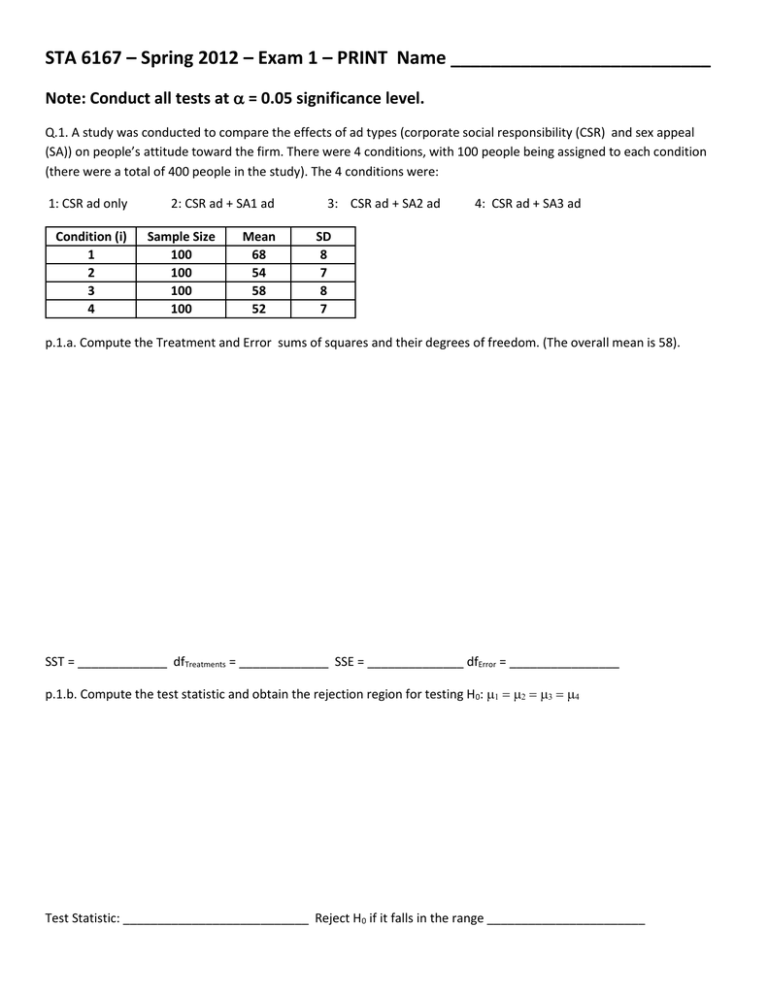
STA 6167 – Spring 2012 – Exam 1 – PRINT Name __________________________ Note: Conduct all tests at = 0.05 significance level. Q.1. A study was conducted to compare the effects of ad types (corporate social responsibility (CSR) and sex appeal (SA)) on people’s attitude toward the firm. There were 4 conditions, with 100 people being assigned to each condition (there were a total of 400 people in the study). The 4 conditions were: 1: CSR ad only Condition (i) 1 2 3 4 2: CSR ad + SA1 ad Sample Size 100 100 100 100 Mean 68 54 58 52 3: CSR ad + SA2 ad 4: CSR ad + SA3 ad SD 8 7 8 7 p.1.a. Compute the Treatment and Error sums of squares and their degrees of freedom. (The overall mean is 58). SST = _____________ dfTreatments = _____________ SSE = ______________ dfError = ________________ p.1.b. Compute the test statistic and obtain the rejection region for testing H0: Test Statistic: ___________________________ Reject H0 if it falls in the range _______________________ Q.2. A multiple regression model was fit, relating consumer’s satisfaction of culinary (food) event (Y) to the following predictor variables/scales: food tasting (X1), food/beverage prices (X2), ease of coming/going to event (X3), and convenient parking (X4). The regression model was fit, based on n=277 respondents, with R2 = 0.44. The regression coefficients are given below, for the model: E(Y) = X1X2X3 X4 Parameter Constant X1 X2 X3 X4 Estimate 1.805 0.327 0.263 0.082 0.025 StdError 0.156 0.041 0.052 0.035 0.042 t 11.571 7.976 2.343 0.595 p.2.a. Test H0: Customer satisfaction is not associated with any of the predictors ( ). p.2.a.i. Test Statistic: p.2.a.ii. Reject H0 if the test statistic falls in the range __________________________________ p.2.b. Test H0: Controlling for all other predictors, customer satisfaction is not associated with food/bev prices (0). p.2.b.i. Test Statistic: p.2.b.ii. Reject H0 if the test statistic falls in the range __________________________________ Q.3. A one-way analysis of variance was conducted to compare 5 conditions in terms of respondents’ beliefs in paranormal activity. The responses are change scores in paranormal beliefs after being exposed to a television show about paranormal events (Positive values mean their beliefs increased, negative mean decreased. There were 22 people in each condition (for a total N=22(5) =110) and the Within Mean Square is MSE = 16. The conditions are (based on disclaimers prior to show): 1: Disclaimer that story in the show is based on reality, but is a re-enactment (Mean1 = -1.0) 2: Disclaimer that the story in the show is purely fiction (Mean2 = -1.6) 3: Disclaimer that the story in the show is impossible (Mean3 = -2.0) 4: No Disclaimer (Mean4 = + 1.6) 5: No story shown (comedy show shown instead) (Mean5 = -0.8) p.3.a. Compute Bonferroni’s minimum significant difference for comparing any 2 pairs of conditions: p.3.b. Complete the following Table (and circle correct decision for each pair, where NSD = not significantly different): i,j 1,2 1,3 1,4 1,5 2,3 2,4 2,5 3,4 3,5 4,5 Mean(i)-Mean(j) 0.6 1 -2.6 -0.2 0.4 -3.2 -0.8 mu(i)<mu(j) mu(i)<mu(j) mu(i)<mu(j) mu(i)<mu(j) mu(i)<mu(j) mu(i)<mu(j) mu(i)<mu(j) mu(i)<mu(j) mu(i)<mu(j) mu(i)<mu(j) Conclude mu(i) > mu(j) mu(i) > mu(j) mu(i) > mu(j) mu(i) > mu(j) mu(i) > mu(j) mu(i) > mu(j) mu(i) > mu(j) mu(i) > mu(j) mu(i) > mu(j) mu(i) > mu(j) NSD NSD NSD NSD NSD NSD NSD NSD NSD NSD Q.4. A linear regression model is fit, relating Y to 3 independent variables. The researcher is interested in determining whether any interactions are significant among the 3 independent variables. She fits the following 2 models (n = 30): Model 1: E Y 1 X 1 2 X 2 3 X 3 R12 0.48 Model 2: E Y 1 X 1 2 X 2 3 X 3 4 X 1 X 2 5 X 1 X 3 6 X 2 X 3 R22 0.54 p.4.a. Compute the test statistic for testing H0: No interactions among X1, X2, and X3 ( ) p.4.b. Reject H0 if the test statistic falls in the range ____________________________________________ Q.5. For the following scenarios, fill in the missing values. p.5.a. Multiple linear regression, n=32 subjects, p=6 predictor variables. Testing H0: Numerator df = ______________ Denominator df = ______________ Rejection Region: Fobs ____________ p.5.b. 1-Way ANOVA (Completely Randomized Design), t treatments, r subjects/Trt. Testing H0: Rejection Region: Fobs ≥ 3.490 # Treatments = t = _________________ # Replicates/Treatment = r = _______________ p.5.c. 2-Way ANOVA (Randomized Block Design), t = 3 treatments, b = 6 blocks. Bonferroni’s Minimum Significant Difference (MSE = 300): t.025,C,df = ______________ SE y i y j =_________________________ Bij = __________________ Q.6. A Randomized Block Design is conducted to compare t = 3 brands of puppy chow on weight gain of puppies. Three male puppies from 6 litters were selected, where the litters are blocks. Within litters, puppies are randomized so that one gets brand A, one gets brand B, and one gets brand C. Data are given in the following table (where the response is weight gain in a 3-week period). Note that the total sum of squares is: TSS = 129.28 Litter\Brand 1 2 3 4 5 6 Brand Mean A 4.20 8.20 2.20 9.40 3.20 8.80 6.00 B 2.80 5.60 2.00 7.20 2.50 3.90 4.00 C 2.00 4.20 1.80 7.40 0.30 2.30 3.00 Litter Mean 3.00 6.00 2.00 8.00 2.00 5.00 4.33 p.6.a. Given the following quantities, complete the ANOVA table (be careful of needed multipliers). 3 4.33 6 4.33 2 4.33 8 4.33 2 4.33 5 4.33 2 2 2 6 4.33 4 4.33 3 4.33 4.67 2 Source Brand (Trt) Litter (Blk) Error Total 2 2 df 2 SS 129.28 2 2 28.80 MS F F(0.05) #N/A #N/A #N/A #N/A #N/A #N/A #N/A Significant Effects? Yes / No #N/A #N/A #N/A p.6.b. Conduct Friedman’s Test to determine whether there are differences among the brands on weight gain: p.6.b.i. T1 = _________________________ T2 = _____________________ T3 = ________________________ p.6.b.ii. Test Statistic: p.6.b.iii. Reject H0 if test statistic falls in the range _________________________________________ Q.7. All possible regressions are fit among models containing 3 potential independent variables. Complete the following table. The models are based on n=24 observations. Model X1 X2 X3 X1,X2 X1,X3 X2,X3 X1,X2,X3 p' SS(Reg) 200 300 500 400 750 SS(Res) R-square MS(Res) Adj-RSq 800 0.164 700 31.818 0.268 500 22.727 0.477 0.343 600 28.571 0.343 0.726 200 10.000 0.781 Cp 60 50 30 AIC 88.157 84.953 76.877 SBC 90.513 87.309 79.233 42 83.253 86.787 4 58.886 63.599 p.7.a. Complete the table. Note: CP SS Error Model MS Error Complete 2 p ' n AIC n ln SS Error Model 2 p ' n ln(n) SBC BIC n ln SS Error Model ln(n) p ' n ln(n) p.7.b. A researcher chooses the best model based on the SBC criterion. Which model will be selected? Why? p.7.c. Another researcher chooses the best model based on CP, which model is selected? Why?




